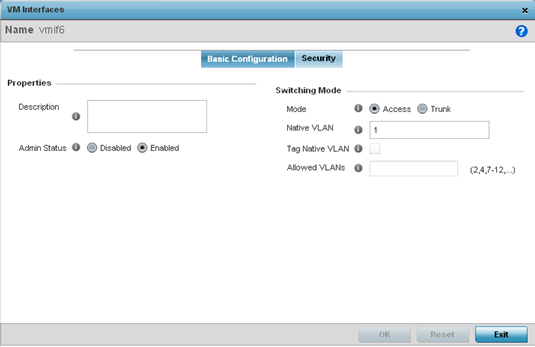To set a VM interface basic configuration for a profile:
Select Configuration > Profiles > Interface.
Expand the Interface menu to display its submenu options.
Select VM.
Select an existing VM interface configuration and select the Edit button. The Basic Configuration tab displays by default.

Set the following VM interface Properties:
|
Description |
Enter a brief description for the controller or service platform VM interface (64 characters maximum). |
|
Admin Status |
Select the Enabled radio button to define this VM interface as active to the profile it supports. Select the Disabled radio button to disable this VM interface configuration in the profile. It can be activated at any future time when needed. The default setting is disabled. |
Define the following Switching Mode parameters to apply to the VM Interface configuration:
|
Mode |
Select either the Access or Trunk radio button to set the VLAN switching mode over the VM interface. If Access is selected, the VM interface accepts packets only from the native VLAN. Frames are forwarded untagged with no 802.1Q header. All frames received on the VM port are expected as untagged and are mapped to the native VLAN. If the mode is set to Trunk, the VM interface allows packets from a list of VLANs you add to the trunk. A VM interface configured as Trunk supports multiple 802.1Q tagged VLANs and one Native VLAN which can be tagged or untagged. Access is the default setting. |
|
Native VLAN |
Use the spinner control to define a numerical Native VLAN ID from 1 - 4094. The native VLAN allows an Ethernet device to associate untagged frames to a VLAN when no 802.1Q frame is included in the frame. Additionally, the native VLAN is the VLAN untagged traffic will be directed over when using trunk mode. The default value is 1. |
|
Tag the Native VLAN |
Select this option to tag the native VLAN. Service platforms support the IEEE 802.1Q specification for tagging frames and coordinating VLANs between devices. IEEE 802.1Q adds four bytes to each frame identifying the VLAN ID for upstream VMIF that the frame belongs. If the upstream VMIF does not support IEEE 802.1Q tagging, it does not interpret the tagged frames. When VLAN tagging is required between VM interface ports, both VM interfaces must support tagging and be configured to accept tagged VLANs. When a frame is tagged, a 12 bit frame VLAN ID is added to the 802.1Q header, so upstream VM interfaces know which VLAN ID the frame belongs to. The 12 bit VLAN ID is read and the frame is forwarded to the appropriate VLAN. When a frame is received with no 802.1Q header, the upstream VMIF classifies the frame using the default or native VLAN assigned to the Trunk port. The native VLAN allows a VM interface to associate untagged frames to a VLAN when no 802.1Q frame is included in the frame. This setting is disabled by default. |
|
Allowed VLANs |
Selecting Trunk as the mode enables the Allowed VLANs parameter. Add VLANs that exclusively send packets over the VM interface. The available range is from 1 - 4094. The maximum number of entries is 256. |
Select OK to save the changes to the VM interface basic configuration. Select Reset to revert to the last saved configuration.